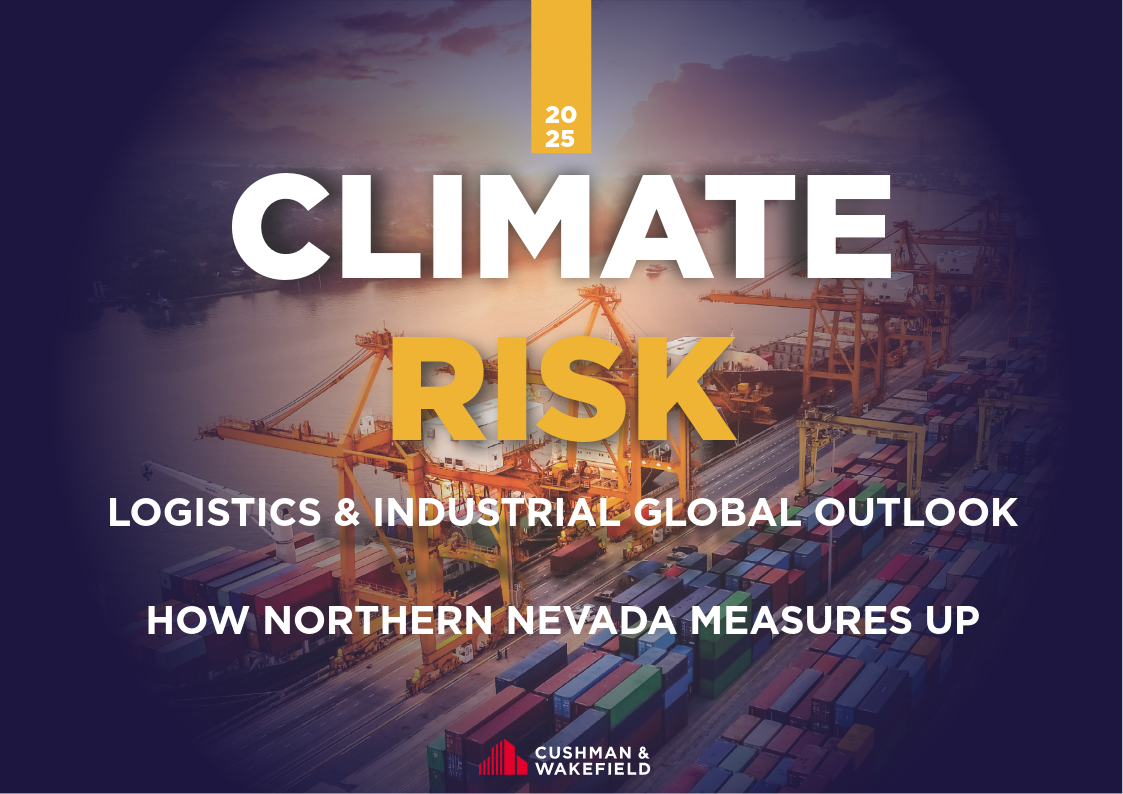Why Climate Risk Is Now a Site Selection Factor for Industrial Occupiers
Logistics & Industrial Global Outlook: How Northern Nevada Measures Up
And what Northern Nevada reveals about resilience, risk, and opportunity.
As occupiers expand their logistics networks and optimize footprints across the U.S., one critical filter is rising to the top: climate risk.
Cushman & Wakefield’s new Climate Risk: Logistics & Industrial Global Outlook offers a comprehensive look at how climate hazards—like heat, drought, flooding, and wildfire—are reshaping the industrial landscape. While the spotlight often shines on investor implications, the occupier perspective is just as critical. Why? Because industrial users can’t afford downtime. When facilities go offline, shipments stall, inventory spoils, and supply chains bottleneck.
This report reminds us that climate risk is not a future concern—it’s a present-day business risk. And it’s influencing how companies lease, operate, and future-proof their space.
What Occupiers Should Be Thinking About
Industrial assets—especially cold storage, data centers, and manufacturing—are less flexible than office buildings. Remote work isn’t an option. So occupiers must get ahead of climate vulnerabilities:
Flood risk can vary from one side of the road to the other. Site-level analysis is essential.
Heat and HVAC loads are rising, pushing OpEx up in affected regions.
Longer lease terms and complex fit-outs make it harder to pivot once risk materializes.
Energy resilience is becoming a value differentiator—from rooftop solar to localized storage.
As tenants gain access to the same data that landlords are using, climate intelligence becomes lease intelligence. This impacts negotiations, incentives, and even retention.
What About Northern Nevada?
From an occupier's lens, Northern Nevada offers a compelling mix of strengths and considerations.
Lower Exposure: Compared to coastal markets, the region is relatively insulated from hurricanes, sea-level rise, and widespread flooding.
Wildfire & Heat Trends: However, growing wildfire risk at the urban edge and intensifying heatwaves mean asset-level strategies matter. Roof insulation, updated HVAC, and defensible landscaping are no longer just upgrades—they’re risk management.
Water & Drought Planning: Chronic drought conditions impact not only agriculture but also industrial users with high water needs. Companies should factor in water rights, supply reliability, and stormwater management at the site level.
Energy Resilience: With large-scale rooftops and declining solar/battery costs, occupiers here are increasingly exploring distributed energy options—especially mission-critical users where outages are not an option.
Strategic Site Selection: Even within Reno-Sparks or the Tahoe-Reno Industrial Center (TRIC), site-specific risks vary. Evaluating exposure and adaptability before signing a lease is simply smart business.
Bottom Line: Resilience isn’t just about weathering storms—it’s about protecting uptime, workforce, and operating cost. Climate risk analysis is no longer optional. It’s a competitive advantage for occupiers who think long-term.
If you're considering your next industrial move—or rethinking your current strategy—now’s the time to look beyond traditional real estate metrics. Understanding your climate exposure is the first step in safeguarding your operations for the years ahead.
For the full report, access here: https://www.cushmanwakefield.com/en/insights/industrial-logistics-climate-risk-outlook
📩 If you're interested in a climate risk snapshot or want to explore the resilience of your current locations, let’s connect.

